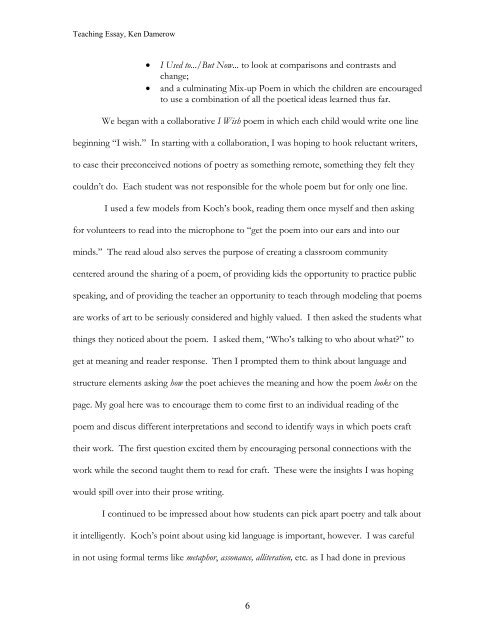An Example of a Teaching Essay - Goddard College's Intranet
An Example of a Teaching Essay - Goddard College's Intranet
An Example of a Teaching Essay - Goddard College's Intranet
You also want an ePaper? Increase the reach of your titles
YUMPU automatically turns print PDFs into web optimized ePapers that Google loves.
<strong>Teaching</strong> <strong>Essay</strong>, Ken Damerow<br />
• I Used to.../But Now... to look at comparisons and contrasts and<br />
change;<br />
• and a culminating Mix-up Poem in which the children are encouraged<br />
to use a combination <strong>of</strong> all the poetical ideas learned thus far.<br />
We began with a collaborative I Wish poem in which each child would write one line<br />
beginning “I wish.” In starting with a collaboration, I was hoping to hook reluctant writers,<br />
to ease their preconceived notions <strong>of</strong> poetry as something remote, something they felt they<br />
couldn’t do. Each student was not responsible for the whole poem but for only one line.<br />
I used a few models from Koch’s book, reading them once myself and then asking<br />
for volunteers to read into the microphone to “get the poem into our ears and into our<br />
minds.” The read aloud also serves the purpose <strong>of</strong> creating a classroom community<br />
centered around the sharing <strong>of</strong> a poem, <strong>of</strong> providing kids the opportunity to practice public<br />
speaking, and <strong>of</strong> providing the teacher an opportunity to teach through modeling that poems<br />
are works <strong>of</strong> art to be seriously considered and highly valued. I then asked the students what<br />
things they noticed about the poem. I asked them, “Who’s talking to who about what?” to<br />
get at meaning and reader response. Then I prompted them to think about language and<br />
structure elements asking how the poet achieves the meaning and how the poem looks on the<br />
page. My goal here was to encourage them to come first to an individual reading <strong>of</strong> the<br />
poem and discus different interpretations and second to identify ways in which poets craft<br />
their work. The first question excited them by encouraging personal connections with the<br />
work while the second taught them to read for craft. These were the insights I was hoping<br />
would spill over into their prose writing.<br />
I continued to be impressed about how students can pick apart poetry and talk about<br />
it intelligently. Koch’s point about using kid language is important, however. I was careful<br />
in not using formal terms like metaphor, assonance, alliteration, etc. as I had done in previous<br />
6



